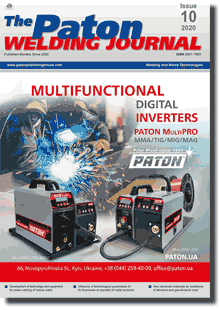| 2020 №10 (01) |
DOI of Article 10.37434/tpwj2020.10.02 |
2020 №10 (03) |

The Paton Welding Journal, 2020, #10, 7-12 pages
Influence of pulsed electromagnetic field treatment on stress-strain state of circumferential welded joints of aluminium АМg6 alloy
L.M. Lobanov1, M.O. Pashchin1, O.L. Mikhodui1, O.V. Cherkashin1, O.M. Timoshenko1, I.P. Kondratenko2 and T.G. Solomiichuk1
1E.O. Paton Electric Welding Institute of the NAS of Ukraine 11 Kazymyr Malevych Str., 03150, Kyiv, Ukraine. E-mail: office@paton.kiev.ua
2Institute of Electrodynamics of the NAS of Ukraine 56 Peremohy Prosp., 03057, Kyiv, Ukraine
Abstract
At present a growing interest in pulsed electromagnetic field treatment technologies is observed to improve the mechanical properties of metals, alloys and welded joints. Based on the pulsed electromagnetic field treatment, effective methods can be developed to optimize the stress-strain state of aluminium alloy products in order to extend their residual life for the use in aircraft and rocket, shipbuilding and other industries. The aim of the work is to study the influence of pulsed electromagnetic field treatment on the stress-strain state of circumferential welded joints of aluminium AMg6 alloy. An original experimental procedure was developed to study the kinetics of the electrodynamic pressure force during treatment of metallic materials with a pulsed electromagnetic field. It is shown that as a result of treatment with a pulsed electromagnetic field in the same conditions, the value of P increased with the use of the screen, which is predetermined by the increase in the active additional volume of the electric conductive medium. It was established that the use of the screen during treatment by a pulsed electromagnetic field helps to reduce the level of residual tensile welding stresses and improve the accuracy of circumferential welded joints. 8 Ref., 3 Tables, 8 Figures.
Keywords: pulsed electromagnetic treatment, aluminium alloy, circumferential welded joints, stress-strain state, residual welded joints, additional screen
Received 01.10.2020
References
1. Lobanov, L.M., Pashchin, M.O., Cherkashyn, O.V. et al. (2019) Prospects for application of electromagnetic fields in welding and related processes. The Paton Welding J., 8, 29-36. https://doi.org/10.15407/tpwj2019.08.052. Batygin, Yu.V., Lavinsky, V.I., Khimenko, L.T. (2003) Pulsed magnetic fields for advanced technologies. Vol.1. 2nd Ed. Ed. by Yu.V. Batygin. Kharkov, MOST-Tornado [in Russian].
3. Turenko, A.N., Batygin, Yu.V., Gnatov, A.V. (2009) Pulsed magnetic fields for advanced technologies. Vol.3: Theory and experiment of attraction of thin-walled metals by pulsed magnetic fields: Monography. Kharkov, KhNADU [in Russian].
4. Strizhalo, V.A., Novogrudsky, L.S., Vorobiov, E.V. (2008) Strength of materials at cryogenic temperatures taking into account electromagnetic fields. Kiev, IPS [in Russian].
5. Lobanov, L.M., Kondratenko, I.P., Pashchin, N.A. et al. (2016) Comparison of influence of pulsed effects of magnetic and electric fields on stressed state of welded joints of aluminium alloy AMg6. The Paton Welding J., 10, 8-13. https://doi.org/10.15407/tpwj2016.10.02
6. Vasetsky, Yu.M., Dzyuba, K.K. (2017) Analytical calculation method of quasi-stationary 3D electromagnetic field of current passed on contour of arbitrary configuration near conductive body. Tekhnichna Elektrodynamika, 5, 7-17 [in Russian]. https://doi.org/10.15407/techned2017.05.007
7. Kistler Instrumente AG. Quartz Accelerometer 8042 (Passport).
8. Rashchepkin, A.P., Kondratenko, I.P., Karlov, O.M., Kryshchuk, R.S. (2019) Electromagnetic field of inductor with E core for magnetic-pulsed treatment of materials. Tekhnichna Elektrodynamika, 6, 5-12 [in Ukrainian]. https://doi.org/10.15407/techned2019.06.005
